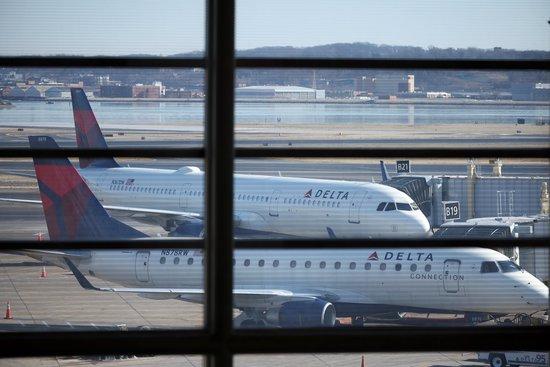


On July 25th, a passenger plane from the airport in Burbank, California, experienced an emergency descent shortly after taking off to avoid a collision with a fighter jet in the air. The incident resulted in two injuries.
This was the fourth such accident involving a passenger plane and a military aircraft this year in the United States.
In a statement, Southwest Airlines reported that after taking off from Burbank for Las Vegas, Nevada, Flight 1496 received an alert that the plane had descended sharply before making an emergency descent. According to reports, Southwest Airlines’ aircraft plummeted about 145 meters. The incident injured two flight attendants.
I estimated it lasted eight to ten seconds. I have never experienced anything like this; it was terrifying, as if my soul had left my body.
Everything went out of control, it was incredibly frightening. At the time, I didn’t know what was happening.
According to US media, the “Hawk Warrior” jet, which was very close to Southwest Airlines’ aircraft, was flying from Texas to a Navy base near Ventura County, Los Angeles.
The Federal Aviation Administration (FAA) stated that they had contacted Southwest Airlines regarding the incident and are conducting an investigation.
A passenger plane preparing to land in North Dakota, USA, had to make a sharp turn to avoid colliding with a B-52 strategic bomber of the U.S. Air Force.
△ A witness captured a B-52 bomber on July 18th
It is reported that Flight 3788 operated by TAM Airlines, a charter flight between Minneapolis, Minnesota, and Minnetonka International Airport in North Dakota, had been granted permission to land by the tower.
But a B-52 bomber suddenly appeared on its flight path,
forcing the flight to make a sharp right turn and then climb around before attempting and completing the landing.
According to live recordings of pilots’ on-site audio disclosed on social media, he explained to passengers:
“I don’t understand why they didn’t notify us in advance because the airbase has radar… Overall, it wasn’t a pleasant experience.”
He stated that the bomber was much faster than the passenger plane, and making a sharp turn was the safest avoidance maneuver.
The U.S. Air Force reported that a B-52 bomber was performing a flyover at the North Dakota State Fair in Minneapolis at that time.
“The distance between the two was just over a hundred meters”
, a United Airlines Boeing 737 carrying 136 people almost collided with an American Air Force T-38 trainer aircraft from Washington D.C., with the two aircraft only about a hundred meters apart.
According to the Federal Aviation Administration, this United Airlines Airbus A319 took off from Reagan National Airport in Washington D.C. at approximately 15:15 on the 28th, heading to Minneapolis. Meanwhile, four T-38 trainer aircraft from the U.S. Air Force were flying towards Arlington National Cemetery airspace near the airport, conducting formation flight missions.
The Federal Aviation Administration said that after takeoff, the United Airlines aircraft received a collision alert “nearby there is another aircraft.” After reporting to the tower, the latter issued a “correction order” to both the aircraft and the related military aircraft.
Data from the Flight Tracking Website “24/7 Flight Radar” showed that during this air incident, an American Air Force T-38 trainer aircraft was flying at a speed higher than 350 miles per hour (about 563 kilometers per hour) and at a height of only 800 feet (about 243 meters) above ground, closely flying over the United Airlines aircraft.
The near collision between the aircraft and the military aircraft once again highlighted issues in the coordination of shared airspace between the U.S. military and civil aviation authorities.
A passenger plane and a helicopter collided in the river
An American Pacific Southwest Airlines passenger plane carrying 64 people landed at Washington Reagan National Airport in the capital, USA, and collided with an Army Black Hawk helicopter carrying three soldiers. The two aircraft plunged into the Potomac River, resulting in no survivors.
The flight altitude of the Black Hawk helicopter at the time of the incident has also sparked controversy. The Federal Aviation Administration (FAA) mandates that helicopters maintain a flight altitude of no more than 200 feet (approximately 61 meters) when nearing Reagan National Airport. On January 31st, US President Donald Trump stated that the Black Hawk helicopter’s altitude was too high, far exceeding the 200-foot limit. On February 4th, the National Transportation Safety Board reported that air traffic control displays showed the Black Hawk helicopter was 300 feet (approximately 91 meters) above the plane during the collision.
On April 27th, local time, according to a report published by The New York Times, prior to the crash in Washington, USA, on January this year,
the pilot of the Black Hawk helicopter did not follow his instructor’s instructions to change course
The report states that when air traffic controllers notified the Black Hawk helicopter of a nearby passenger plane, the pilot and his instructor confirmed the information and requested to fly “separate visually.” “Separate visually” is a common practice that allows the aircraft to avoid collision based on its own observations.
According to the report, 15 seconds before the Black Hawk helicopter’s trajectory intersected with the passenger plane’s flight path,
the helicopter pilot’s instructor told him he believed air traffic control wanted them to turn left.
The report mentioned that turning left could have created more space between the helicopter and the passenger plane, but the helicopter did not turn left.